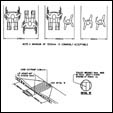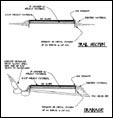
Mobility for all
Getting to a transit stop
by Tom Rickert
Entire guide as a PDF file (1.43 MB)
Streets and pathways
Access to transportation is not just a matter of being able to ride on buses and trains. Transportation access also benefits from changes in the attitudes other people have toward persons with disabilities. Prejudice against disabled persons will hinder the success of even the best efforts to improve access. Also, those who have mobility difficulties may need practical, low cost and easily repaired mobility aids, including wheelchairs, canes, walkers and crutches.
But even with good attitudes, good mobility aids, and access to transit vehicles, disabled people also need pedestrian pathways, which are free of barriers in order to get to a bus stop or a train station. Barriers can include curbs, potholes, muddy pathways, drainage ditches, piles of refuse, broken pavement or sidewalks, or grates with openings so large that they catch wheelchair wheels or canes. In cold climates, piles of snow can also be a barrier.
The photo at the upper left shows a "curb ramp" (curb cut) in the United States, with a slope between the sidewalk and street which easily permits a person riding a wheelchair to cross the street. The diagram below left, from Canada, shows ideal sidewalk widths to enable wheelchair users to travel freely, with specifications for curb ramps.
The diagram at the upper right, also from Canada, shows how a blind pedestrian benefits from having a flat smooth surface to walk on, with tree limbs out of the way, grates with small openings (or better still, no grates at all), and without objects such as news stands blocking the pathway.
The diagram below at right notes the proper construction of unpaved pedestrian pathways, which are designed for proper drainage. Pathway soil should be stabilized if possible. Governments unable to afford paved side walks should have a program to maintain pedestrian pathways in as good condition as possible.
In every country and at all levels of government, programs are needed to prevent pedestrians from having to walk in traffic lanes used by vehicles. Around the world, tens of thousands of pedestrians are killed or become disabled every year due to a lack of pedestrian pathways.
Transportation managers need to work with the city departments in charge of streets and pedestrian pathways to make sure that all their passengers can get to their bus stops or railroad stations.
Such coordination will assure that pedestrian pathways provide an unbroken path of travel to transit stops. Sidewalks and waiting areas should be well illuminated. Bus stop markers, benches and shelters should contrast with their surroundings to assist all passengers, including those who are partially sighted. When possible, seats should be provided at transit stops to assist frail elders and others that find it difficult to stand and wait for their vehicle.
(In actual use in any given city or country, local conditions and regulations will determine building materials and safety standards. Photographs and diagrams in this publication do not necessarily represent the standards currently in use in the USA, where this publication is written.)


continued...Access to parking space